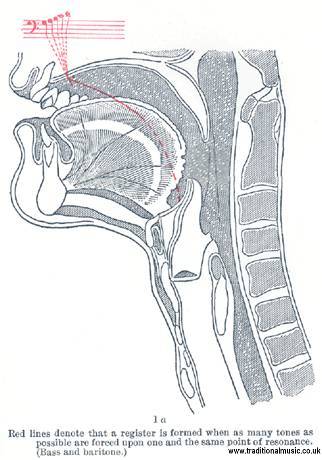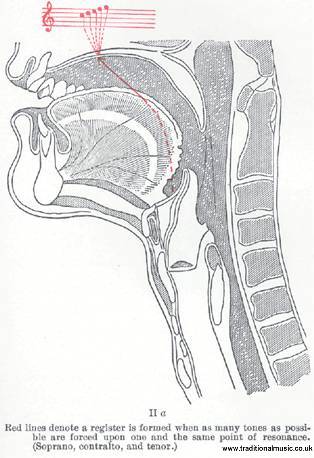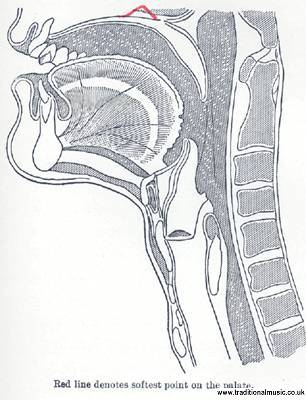Singing - How To Sing 14-15
| Share page | Visit Us On FB |
SECTION XIV
ON VOCAL REGISTERS
What is a vocal register ?
A series of tones sung in a certain way,
which are produced by a certain position
of the vocal organs — larynx, tongue, and
palate. Every voice includes three registers
— chest, middle, and head. But all are not
employed in every class of voice.
Two of them are often found connected
to a certain extent in beginners; the third
is usually much weaker, or does not exist
at all. Only very rarely is a voice found
naturally equalized over its whole compass.
Do registers exist by nature ? No. It
may be said that they are created through
long years of speaking in the vocal range
that is easiest to the person, or in one
adopted by imitation, which then becomes
133
134 HOW TO SING
a fixed habit. If this is coupled with a
natural and proper working of the muscles
of the vocal organs, it may become the ac-
customed range, strong in comparison with
others, and form a register by itself. This
fact would naturally be appreciated only
by singers.
If, on the other hand, the muscles are
wrongly employed in speaking, not only the
range of voice generally used, but the whole
voice as well, may be made to sound badly.
So, in every voice, one or another range may
be stronger or weaker; and this is, in fact,
almost always the case, since mankind speaks
and sings in the pitch easiest or most ac-
customed, .without giving thought to the
proper position of the organs in relation to
each other; and people are rarely made to
pay attention as children to speaking clearly
and in an agreeable voice. In the most for-
tunate instances the range thus practised
reaches limits on both sides, not so much
those of the person's power, as those set
|
|
ON VOCAL REGISTERS 139
by his lack of skill, or practice. Limitations
ure put on the voice through taking account
only of the easiest and most accustomed
thing, without inquiring into the potentiali-
ties of the organs or the demands of art.
Now, suppose such a peculiarity which in-
cludes, let us say, three or four tones, is
extended to six or eight, then, in the course
of time, in the worst cases, a break is pro-
duced at the outside limits. In the most
favorable cases the tones lying next beyond
these limits are conspicuously weak and with-
out power compared with those previously
forced. This one way of singing can be used
no farther; another must be taken up, only,
perhaps, to repeat farther the incorrect pro-
cedure.
Three such limits or ways of singing can
be found and used. Chest, middle, and head
^oice, all three form registers when exag-
gerated; but they should be shaded off and
melt into each other. The organs, through
the skilful training of the teacher, as well
140 HOW TO SING
*
as by the exercise of the pupil's talent and
industry, must be accustomed to taking such
positions that one register leads into another
imperceptibly. In this way beauty, equality,
and increased compass of .the voice will be
made to enhance its usefulness.
When the three ways of singing are too
widely different and too sharply contrasted,
they become separate registers. These are
everywhere accepted as a matter of course,
and for years have been a terror in the
teaching of singing, that has done more than
anything else to create a dreadful bewilder-
ment among singers and teachers. To eradi-
cate it is probably hopeless. Yet, these regis-
ters are nothing more than three disconnected
manners of using the vocal and resonating
apparatus.
With all the bad habits of singers, with
all the complete ignorance of cause and
effect, that prevail, it is not surprising that
some pretend to tell us that there are two,
three, four, or five registers, although as a
ON VOCAL REGISTERS 141
matter of fact there can be at most three
in any voice. It will be much more correct
to call every tone of every voice by the name
of a new additional register, for in the end,
every tone will and must be taken in a dif-
ferent relation, with a different position of
the organs, although the difference may be
imperceptible, if it is to have its proper
place in the whole. People cling to the
appellations of chest, middle, and head
register, confounding voice with register, and
making a hopeless confusion, from which
only united and very powerful forces can
succeed in extricating them.
As long as the word "register" is kept in
use, the registers will not disappear. And
yet, the register question must be swept
away, to give place to another class of ideas,
sounder views on the part of teachers, and a
truer conception on the part of singers and
pupils.
DEVELOPMENT AND EQUALIZATION
Naturally, a singer can devote more
strength to the development of one or two
connected ranges of his voice than to a
voice perfectly equalized in all its accessible
ranges. For this are required many years
of the most patient study and observation,
often a long-continued or entire sacrifice of
one or the other limit of a range for the
benefit of the next-lying weaker one; of
the head voice especially, which, if unmixed,
sounds uneven and thin in comparison with
the middle range, until by means of practised
elasticity of the organs and endurance of the
throat muscles a positive equalization can
take place.
Voices which contain only one or two
registers are called short voices, for their
142
DEVELOPMENT AND EQUALIZATION 143
availability is as limited as they are them-
selves.
Yet it must be remembered that all voices
alike, whether short or long, even those of
the most skilful singers, when age comes on,
are apt to lose their highest ranges, if they
are not continually practised throughout
their entire compass with the subtlest use of
the head tones. Thence it is to be concluded
that a singer ought always to extend the
compass of his voice as far as possible, in
order to be certain of possessing the com-
pass that he needs.
On the formation of the organs depends
much of the character of the voice. There
are strong, weak, deep, and high voices by
nature; but every voice, by means of proper
study, can attain a certain degree of strength,
flexibility, and compass.
Unfortunately, stubbornness enters largely
into this question, and often works in oppo-
sition to the teacher. Many, for instance,
wish to be altos, either because they are
144 HOW TO SING
afraid of ruining their voices by working for
a higher compass, or because it is easier for
them, even if their voices are not altos at
all.
Nowadays operas are no longer composed
for particular singers and the special char-
acteristics of their voices. Composers and
librettists express what they feel without
regard to an alto singer who has no high
C or a soprano who has no low A flat or
G. But the artist will always find what
he needs.
Registers exist in the voices of almost all
singers, but they ought not to be heard,
ought not, indeed, to exist. Everything
should be sung with a mixed voice in such
a way that no tone is forced at the expense
of any other. To avoid monotony the singer
should have at his disposal a wealth of means
of expression in all ranges of his voice. (See
the Varieties of Attack and Dynamic Power.)
Before all else he should have knowledge of
the advantages in the resonance of certain
DEVELOPMENT AND EQUALIZATION 145
tones, and of their connection with each
other. The soul must provide the color;
skill and knowledge as to cause and effect,
management of the breath, and perfection of
the throat formation must give the power
to produce every dynamic gradation and
detail of expression. Registers are, accord-
ingly, produced when the singer forces a
series of tones, generally ascending, upon one
and the same resonating point, instead of
remembering that in a progression of tones
no one tone can be exactly like another, be-
cause the position of the organs must be
different for each. The palate must remain
elastic from the front teeth to its hindmost
part, mobile and susceptible, though imper-
ceptibly, to all changes. Very much depends
on the continuous harmony of action of the
soft and hard palate, which must always be
in full evidence, the raising and extension
of the former producing changes in the tone.
If, as often happens when the registers are
sharply denned, tones fall into a cul de sac,
146 HOW TO SING
escape into another register is impossible,
without a jump, which may lead to disaster.
With every tone that the singer has to sing,
he must always have the feeling that he
can go higher, and that the attack for dif-
ferent tones must not be forced upon one
and the same point.
The larynx must not be suddenly pressed
down nor jerked up, except when this is de-
sired as a special effect. That is, when one
wishes to make a transition, legato, from a
chest tone to a tone in the middle or head
register, as the old Italians used to do, and
as I, too, learned to do, thus: —
![]()
In this case the chest tone is attacked
very nasal, in order that the connection may
remain to the upper note, and the larynx
is suddenly jerked up to the high tone.
This was called breaking the tone; it was
very much used, and gave fine effects when
DEVELOPMENT AND EQUALIZATION 147
it was well done. I use it to-day, especially
in Italian music, where it belongs. It is
an exception to the rule for imperceptible
or inaudible change of position of the or-
gans,— that it should not be made suddenly.
The scale proceeds from one semitone to
another; each is different; each, as you go
on, requires greater height, wherefore the
position of the organs cannot remain the
same for several different tones. But, as
there should never be an abrupt change
audible in the way of singing, so should
there never be an abrupt change felt in the
sensations of the singer's throat. Every tone
must be imperceptibly prepared in an elastic
channel and must produce an easy feeling
in the singer, as well as an agreeable im-
pression upon the listener.
The small peak indicated in the illustra-
tion is enormously extensible and can be
shifted into infinite varieties of position.
However unimportant its raising and lower-
ing may appear, they are nevertheless of
148 HOW TO SING
great importance for the tone and the singer.
The focal point of the breath, that forms
simultaneously the attack and the body of
the tone, by the operation of the abdominal
breath pressure against the chest, is always
firmly placed on, beneath, or behind the nose.
Without body even the finest pianissimo has
no significance. The very highest unmixed
head tones are an exception, and they can
express nothing. There can be no body ex-
pected in them. Their soaring quality of
sound endures no pressure, and consequently
gives no expression, which is possible only
through an admixture of palatal resonance.
Their only significance is gained through
their pure euphony.
All vowels, too, must keep their point of
resonance uninterruptedly on the palate.
All beauty in the art of song, in cantilena
as well as in all technique, consists chiefly
in uninterrupted connection between the
tone and the word, in the flexible connec-
tion of the soft palate with the hard, in the
|
DEVELOPMENT AND EQUALIZATION 151
continually elastic adjustment of the former
to the latter. This means simply the elastic
form, which the breath must fill in every
corner of resonating surface without inter-
ruption, as long as the tone lasts.
If the singer will control his tone, — and
in practising he must always do so, — he
needs only to test it to see whether he can
easily make it softer without perceptible
change in the position of the organs, and
carry it higher toward the nose and the
cavities of the forehead; that is, prepare a
form for its continuation upward.
In this way he can learn how much height
a tone needs without being too high, and how
much it often lacks in height and duration
to sound high enough.
In this way remarkable faults become evi-
dent! The reason why a tone sounds too
low — the so-called transition tones from the
lower to the middle range and from this
to the higher, come up for consideration
chiefly — is that the pillars of the fauces
152 HOW TO SING
are raised too high toward the back, pre-
venting the head tones from sounding at
the same time; or the soft palate is lowered
too far under the nose, which results in press-
ing the tone too long and too far toward the
teeth. This fault is met with in very many
singers, in all kinds of voices, and in almost
the same places. It comes only from an
unyielding retention of the same resonating
point for several tones and a failure to bring
in the resonance of the head cavities. The
"propagation form," or continuing form, 1
must always be prepared consciously, for with-
out it artistic singing is not to be thought of.
The neglect of this most important princi-
ple usually results in overstraining the vocal
cords and throat muscles. This is followed
first by singing flat, and later by the appear-
ance of the hideous tremolo (see Tremolo) to
1 " Fortpflanzungsform ": the preparation made in the
vocal organs for taking the next tone before leaving the
one under production, so that the succeeding tones shall
all be of like character and quality.
DEVELOPMENT AND EQUALIZATION 153
which so many singers fall victims. The
cause of a tone's being too sharp is the dwell-
ing too long on the resonance of the head cavi-
ties, where the tone should already have been
mixed with palatal resonance. With very
young voices this can easily happen, and
can also result from weariness, when the
bodily strength is not developed sufficiently
to endure the fatigue of practising. A very
circumspect course must then be followed.


